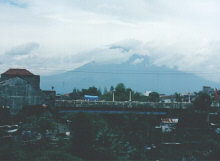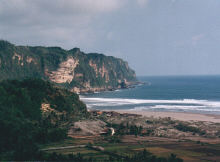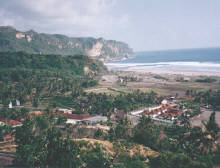When most people think of Indonesia, the idyllic island paradise of Bali springs to mind. A one hour flight from the island of Bali is the neighbouring island of Java – Indonesia’s most densely populated island. It is prolific not only in the cultural history of Indonesia, but also an island of panoramic beauty and friendly people.

Not far from the rugged southern coastline of Central Java is situated the small city of Yogyakarta. The renowned centre of Javanese culture with a population in excess of three million people, it is peacefully nestled in the shadows of the Menoreh Hills and overlooked by the volatile volcano, Mount Merapi. During the Dutch occupation of Indonesia before Independence was declared in 1945, Yogyakarta was the centre for the resistance fighters and a symbol of struggle for all Indonesians. The city even held the honoured title of being the capital of Indonesia before Jakarta.
Yogyakarta possesses many unique attractions and thousands of tourists flock there each year to see the wonders of Borobudur – one of the biggest Bhuddist monuments in the southern hemisphere – the architectural beauty of the Kraton or Sultan’s Palace, and the Hindu temple complex of Prambanan.
Jalan Malioboro (Malioboro Road), is a two kilometre one-way street that runs from north to south in the centre of the city. It is here where the main activity of Yogyakarta exists, where rows of street stalls abound with every imaginable handicraft for sale. These stalls trade in coexistence with the more established shops making it a haven for shopaholics. Besides the main tourist sites, Yogyakarta is plentiful in the Arts, Drama and Dance and proudly boasts the many institutes available for creativity. With its unique atmosphere and friendliness, is it not surprising that Yogyakarta has been referred to as ‘The biggest village in the world’.

The city is a delight for food lovers. Restaurants are numerous, serving virtually all the tastes of Indonesia, but it is the Lesehan or street food stalls that Yogyakarta is famous for. Every night around 9pm, small open-front tents are constructed along the main centre of Malioboro, and straw mats are laid out along the pavements. These street stalls offer such delicacies as Nasi Gudeg – the traditional food of Yogyakarta – Jackfruit cooked in Coconut milk with boiled rice, Ayam Goreng or fried chicken highly spiced and cooked slowly in woks over a kerosene cooker. Every kind of food is available to suit the palate. Kodok (Frogs), Burung Dara (Pigeon), fish of all shapes and sizes and a potpourri of other foods. The Lesehan stalls trade until the very early hours of the morning and in some stalls, music is even provided by the many wandering musicians who literally ‘sing for their supper’. For the less adventurous traveller, many restaurants serve Western foods, however, to experience the beauty of what Yogyakarta is, one must let the cultural beauty seep into one’s soul, tastebuds and thoughts.
To the south of Yogyakarta, where the Indian Ocean sends forth huge swells to crash on the shores, are an abundance of beaches stretching for hundreds of miles along the coast of southern Java – each unique in its own right and beauty, and each with its own history. When my long time Javanese friend and driver, Surya, suggested we visit the beach, my first reaction was to wonder why. Considering all the cultural beauty that Yogyakarta possesses, I could not understand why a trip to the beach would be culturally enlightening – it was.
In the Bantul Regency, twenty-eight kilometres south of Yogyakarta, lies the peaceful idyllic village of Parangtritis. Rugged limestone cliffs overlook huge waves pounding the shoreline; the wide expanse of sand dunes merging into the black sandy beach. During the rainy season the beach is windswept at times; and during the dry season – very hot. Immensely popular, tourists and locals alike travel to Parangtritis not only for the sunbathing and swimming; but also for the fishing, and the tranquil setting ideal for meditation. Delman – two wheeled horse drawn buggies – transport people to and fro along the vast expanse of sand; the horses aimlessly trudging as they go in the thickness of the black sand. The heat of the day can be refreshingly satiated with milk fresh from the green coconuts sold at the numerous palm-thatched pagodas. Ageing Javanese women chatter amongst themselves in Bahasa Jawa not caring (or even looking!) as they slice the head off a coconut with one swish of a machete. Food stalls abound with tempting delights. Hotels and losmens catering for those wishing a longer stay are scattered throughout the village.

Parangtritis is steeped in Javanese mysticism and culture. It is believed there is a south axis connecting Mount Merapi, the Kraton and Parangtritis Beach. According to legend, the Queen of the South Seas – Kanjeng Ratu Kidul together with her confident Nyai Loro Kidul reign over the Southern seas and all within it. It is said that any person wearing clothing coloured green will be lured into the sea by the Queen and to their fate – a superstition firmly entrenched in the minds of all Javanese; even as far North as Jakarta. It is the legend of Parangtritis that entrances all who listen – according to the legend, Kanjeng Ratu Kidul was at one time wed to Panembahan Senopati, a ruler of the mighty Mataram kingdom and enjoyed his company on occasions. The Western section of Parangtritis beach – Parangkusumo Beach – is believed to have been the meeting place between the two mighty rulers; that of the sea and of the land.
It is also at Parangkusumo Beach where the ceremony of ‘Labuhan’ is performed, coinciding with the inaugural commemoration of Sri Sultan Haamengku Buwono X. Each year, on the 30th day of the Javanese month of ‘Rejeb’, offerings are given to Kanjeng Ratu Kidul. These offerings, in the ceremony of Labuhan, consist of fingernail cuttings and hair of the Sultan of Yogyakarta, food and clothing – all cast into the sea in the hope that the Sultan and the people of Yogyakarta will have continuous peace and prosperity. The same ceremony is held on top of Mount Merapi and Lawu.
According to legend, volcanic activity also occurred at Parangkusumo Beach. This resulted in a formation of rocks supposedly where the Sultan of Yogyakarta and Kajeng Ratu Kidul met to discuss the well-being of the people of Yogyakarta – and of their love for each other. Upon this formation of rock was built a small rest house. On two special nights – Friday and Tuesday Kliwon according to the Javanese calendar – people come from all over to meditate in the spiritual ambience. Most nights, people can be found meditating at this small rest place – a place of peace and harmony with the sea and land.
A mineral hot spring, named Parang Wedang, with continuous flowing water attracts visitors who bathe there because it is believed to have healing properties for skin ailments – although not in need of it, I found the water to be soothing and pleasant. Small change rooms or lidos are available for those wishing to bathe in private. The pool, as I was told, was found by Sri Sultan Hamengku Buwono VII. He found it his duty to care for the pool. Many locals believe the place to be a sacred site – many meditate there and congregate to discuss matters of importance affecting their village. Further down the beach to the east there is Langse Cave; another place of meditation. Although it is not for the feint-hearted, the cave itself is only accessible by bamboo ladders and rattan ropes making the sojourn to spiritual serenity almost like a rite of passage. Once down at the opening, the mouth of the cave lies bare to the Indian Ocean. It is understandable that the cave is a place of spiritual perfection; a connection of oneself with the Queen of the South Seas.

Surya, my driver, suggested a better view. “Of what?” I asked, knowing that nothing could be more beautiful; or even delightful. After haphazard scrambling upwards from the cave, I was soon in the safety of the car. It wasn’t until we arrived a short while later, the light fading as the day came to an end, did I realise just how beautiful Parangtritis really is. The lookout – called Gambirowati Plateau – is a limestone hill, pancake flat on top with a few dried palm covered pagodas high above Parangtritis, and easily accessible by a narrow dirt track; however during the rainy season; quite hazardous. From the lookout, it is an endless horizon of beauty. I gazed at the sun disappearing into the Indian Ocean, the lights of the village flickering below. I thought of Nyai Loro Kidul. Perhaps because of the green coconuts I had drunk from earlier, the green shirt I was wearing, or the green car that was my transport to Yogyakarta.
Questions?
If you want more information about this area you can email the author or check out our Asia Insiders page.
![]()